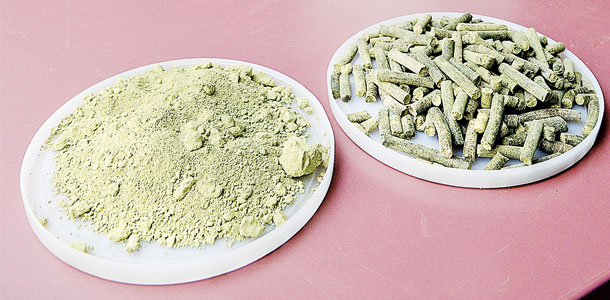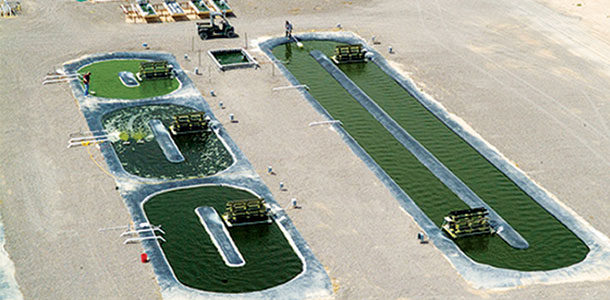Cattle were designed to convert low-quality nutrients into high-quality foods, such as dairy and meat products. For the last 15 years, energy co-products (distillers grains) have comprised an increasing proportion of cattle rations, as ethanol producers strive to extract value from their co-product.
Cattle were designed to convert low-quality nutrients into high-quality foods, such as dairy and meat products. For the last 15 years, energy co-products (distillers grains) have comprised an increasing proportion of cattle rations, as ethanol producers strive to extract value from their co-product.
Accordingly, researchers and companies who seek second-generation and third-generation sources of biofuel consider cattle a suitable market for potential co-products.
One source of biofuel recently drawing considerable attention is microalgae. The basic processes used to produce oil from microalgae are comparable to that of soybeans: Algae is grown, accumulates lipid, is harvested, and the oil is extracted. In a laboratory setting, some species of algae can approach 50 percent lipid; however, most algae produced in open ponds contain less lipid.
While the lipid content of algae is higher than soybeans, extraction of 1 pound of oil still results in the production of at least one pound of co-product, post-extraction algal residue (PEAR). Production of PEAR in equal to or larger amounts than oil dictates developing an effective market for PEAR, and is essential to the economic and environmental sustainability of algal biofuel production.
Currently, it is difficult to pinpoint the composition and characteristics of PEAR, when and if it becomes available to livestock producers. In contrast to the relatively standardized relationships between corn and distillers or soybeans and soybean meal, there is no clear definition of what PEAR is today, tomorrow or will be in the future.
Microalgae producers are still determining what species of microalgae to grow, how it will be cultivated, harvested and extracted, making a clear explanation of what PEAR is virtually impossible. Therefore, an essential step in researching biofuel from microalgae is moving toward a clear definition of the species, the processes and how they impact the nutritional value of PEAR produced.
The Animal Nutrition Section in the Department of Animal Science at Texas A&M University began describing PEAR as a nutrient source in cattle by completing three projects using PEAR as a protein supplement in cattle fed low-quality forage.
Currently, additional work is being conducted in growing and finishing cattle. Identification of a microalgae producer capable of producing a couple of tons of PEAR proved to be a significant challenge to describe PEAR in cattle diets, suggesting it may be a while before PEAR is commercially available.
 PEAR used in these projects was spray-dried; thus, it arrived as a pale green, extremely fine dust. Photo courtesy of Tryon A. Wickersham.
PEAR used in these projects was spray-dried; thus, it arrived as a pale green, extremely fine dust. Photo courtesy of Tryon A. Wickersham.
The PEAR used in the first three projects contained 53 to 56 percent organic matter, 18 to 19 percent crude protein, 7.5 percent calcium, 0.6 percent phosphorus, 0.8 percent sulfur and 5.2 percent sodium. Additionally, it contained 4,600 ppm iron and 2,500 ppm aluminum.
Relatively high iron and aluminum concentrations result from the use of flocculants to harvest the algae and may constrain the inclusion of PEAR in diets. An additional concern is the use of copper in pond management; in a separate project, samples were analyzed which contained more than 2,000 ppm copper.
The PEAR currently being used in our growing and finishing projects contains more protein (more than 30 percent crude protein), less ash, and lower aluminum, copper and iron, demonstrating the commitment of our partner to producing higher-quality PEAR.
An obvious question after determining nutritive value was, âWill cattle eat PEAR?â In order to answer this question, the handling characteristics of PEAR needed to be improved. As previously mentioned, PEAR used in these projects was spray-dried; thus, it arrived as a pale green, extremely fine dust.
To enable consumption and prevent inhalation, PEAR was pelleted and subsequently crumbled. Pelleting reduced the dust, and crumbling allowed effective mixing with other feedstuffs (i.e., dried distillers grains and cottonseed meal).
Steers were given one hour to consume approximately 2 pounds of supplements containing up to 60 percent PEAR (40 percent of either dried distillers grains or cottonseed meal, depending on the blend). Supplements containing PEAR were consumed at a similar rate and to a similar extent as 100 percent dried distillers grains and 100 percent cottonseed meal.
Provision of a supplement containing 100 percent PEAR resulted in incomplete consumption of the allotted supplement 45 percent of the time. In a subsequent study, steers provided access to water and given the entire day to eat the 100 percent PEAR supplement consumed the allotted supplement 100 percent of the time.
In the same study, it was noted that steers would eat the supplement and then drink a significant amount of water. Additionally, steers fed PEAR excreted 64 percent more urine than steers fed the same amount of crude protein from cottonseed meal, suggesting unrestricted access to water is essential in diets containing PEAR.
Greater intake of calcium and sodium with PEAR may alter rumen osmolarity, resulting in the drive to consume water or stop eating the supplement. Confirmation of the willingness of cattle to consume PEAR allowed the research to move forward and focus on describing animal utilization of protein from PEAR.
Protein utilization was determined by describing the ability of PEAR to promote intake and digestion of low-quality forage (less than 7 percent crude protein). Nitrogen retention was also measured.
Both studies consisted of a negative control (steers receiving no supplement) and a positive control (steers receiving cottonseed meal, fed to provide the same amount of protein per day as the PEAR). A typical response to supplemental protein is an increase in total digestible organic matter intake (i.e., an increase in digestible energy intake).
Cottonseed meal was used as a positive control because it is a common protein supplement in Texas. In both studies, there was no difference in the ability of PEAR and cottonseed meal to promote intake of digestible organic matter or nitrogen retention. In the second study, three levels of PEAR were supplemented.
At the highest level of PEAR supplementation, total digestible organic matter intake was 48 percent more than for steers receiving no supplement. These observations suggest the PEAR tested was a suitable protein replacement provided supplements are formulated to address mineral deficiencies and imbalances.
As previously mentioned, research using PEAR in growing and finishing diets is ongoing; however, future research is needed to evaluate PEAR in dairy diets.
Microalgae is currently receiving much attention as a possible source of biofuel; however, significant barriers exist, hindering it from becoming a viable source of biofuel. Removal of those barriers with technology may result in algal biofuel becoming a reality; at which time, a portion of the co-product, PEAR, may need to be marketed in cattle production systems.
Development of fuel production processes in partnership with animal scientists, nutritionists and livestock producers will allow algal biofuel producers to generate a safe and valuable co-product cattle producers can use to produce meat and milk.






